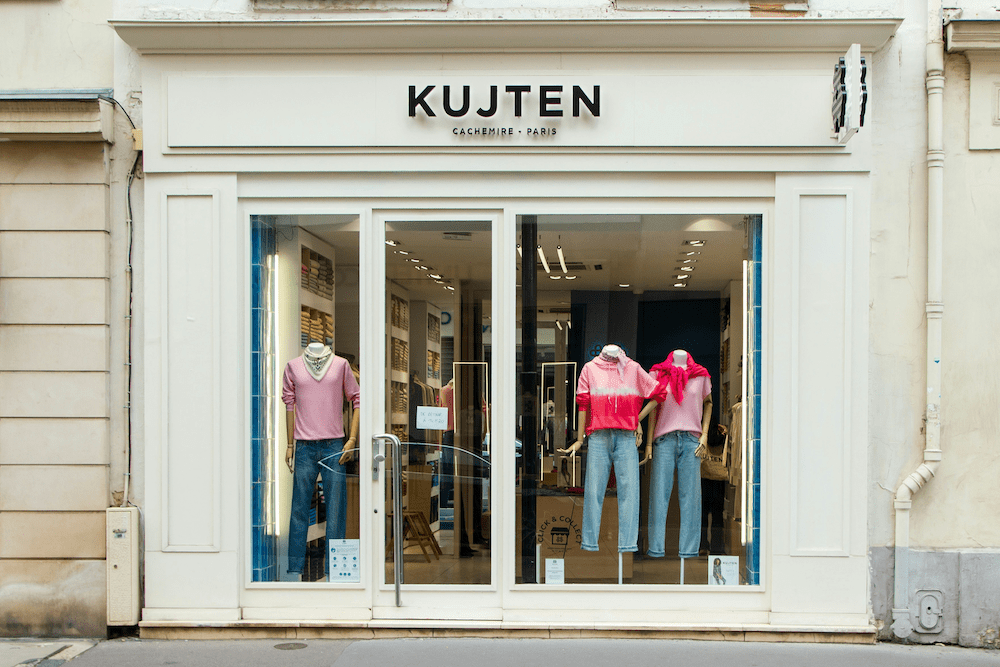
eCommerce
How to Calculate Startup Costs for a Clothing Store?
When you're launching a clothing store, it's super important to have a handle on all your expenses. Think of "startup...
20 Boutique Interior Decor Ideas to Give a Go
Editor's Picks
+1

Steve Jobs once stated, "Design is not just what it looks and feels like. Design is how it works."
Decor is one of the most important things to consider when opening your boutique. It may not seem like that in the beginning, but statistics have shown that a large majority of shoppers, 84%, said they would return to boutiques that have a friendly and nice environment.
So, let’s set the right mood for your boutique by exploring more of what you should keep an eye on.
Decorating your clothing store isn’t just about displaying your products—it’s about creating an experience that reflects your brand and makes customers feel welcome.
Let’s explore some boutique decor ideas that can elevate your space and transform your customers’ shopping experience.
A well-placed mirror can instantly make a boutique feel bigger and more open.
Mirrors reflect light, brightening up dark corners and creating a sense of openness and spaciousness in your boutique. If your boutique is smaller, adding a few mirrors will help open things up without requiring a complete renovation.
Suppose you have a product display that you want to draw attention to; place a mirror nearby to reflect it. Plus, mirrors are great for customers who want to check out how an outfit looks on them without having to step into a dressing room.
Lighting is more than just a way to illuminate your boutique—it’s a key player in setting the mood and creating an inviting atmosphere.
The right lighting can highlight your boutique’s unique branding and create a welcoming atmosphere for customers, making it worthwhile to invest time and effort into selecting it.
Types of boutique lighting you can use:
Adding indoor plants to the décor of your shop is a practical approach to bringing a little bit of nature inside your business and creating a peaceful, welcoming ambiance.
Plants improve the aesthetics and atmosphere of your shop and help improve the air quality in the area.
A little greenery can make a big difference in a space. Succulents, ferns, and even little trees are examples of plants that provide vitality and a more laid-back, organic vibe to your store. They can soften the sharp edges of architectural elements or furnishings and look great in almost any setting.
Designing cozy fitting rooms will help your customers feel more comfortable. You can start by adding warm and ambient lighting, such as soft sconces or pendant lights with bulbs, to create a cozy atmosphere.
Placing some chairs, along with racks for hanging garments and a few mirrors for customers to admire their outfits from various angles will significantly improve the overall shopping experience as well.
Additionally, you might want to set up a small waiting area close to the fitting rooms where friends and family can relax while waiting.
Soft seating areas can be a fantastic enhancement for your boutique, providing a space where customers can relax and destress.
Think about adding comfortable chairs or cozy couches that encourage them to sit down and stay a while. Including soft throws can boost comfort and make the area even more comfortable.
This space is an excellent place for customers to try on accessories or have conversations with friends while shopping.
A bookshelf is a charming way of displaying your merchandise. Combine fashion books and magazines to create an inviting appearance.
You can arrange some books horizontally and place attractive objects on top to add height and visual interest.
Don’t be afraid to let your store’s personality shine through. Use pieces that resonate with you and your boutique, whether a vintage find or a sleek modern item.
Using art and murals in your boutique can completely change its appearance and help it stand out from other stores.
Putting artwork on your walls can give your boutique a special feeling that reflects your brand’s values. This can help your customers understand your vision and beliefs.
Whether you have a colorful mural that tells a story or fascinating art pieces such as paintings or photographs, it can grab customers’ attention and keep them interested while they shop.
Now that we have explained how arts and murals can positively influence your store decor, you might also be interested in hearing advice or two about choosing local artists.
You can partner with local artists or craftsmen and have them create pieces for display in your store.
This will add to the shopping experience and cater to a wide range of demographics who believe in community and collaboration.
Understanding color psychology is very important when designing the inside of a boutique.
Each color affects how customers perceive your brand. Different colors evoke various emotions and help set the right vibe that aligns with your brand’s identity.
For example, soft shades like pink or light green can create a calm and inviting atmosphere, perfect for boutiques that want to highlight luxury or comfort and aim for a more sophisticated look.
In contrast, vibrant colors like red or orange can energize the space, making it ideal for stores focused on creating a more energetic atmosphere. Meanwhile, neutral tones like nudes or grey offer a simple and minimalist design.
By thoughtfully selecting your color palette, you can enhance the shopping experience and make your boutique more appealing, encouraging customers to spend more time browsing–and money.
Open shelves have the potential to turn your boutique into a gallery-like setting. Organizing clothes items by color or theme allows you to create an attractive product display that encourages customers to explore your curated collections easily.
Madwell uses open shelves to display their fashionable denim and casual attire. By arranging pieces in coordinated color schemes, they enable customers to easily mix and match their outfits.
Vintage or wooden ladders can serve as unique display units.
They add a nice aesthetic while also serving as a display for clothing, accessories, or even plants. This creates a warm and inviting atmosphere in your store.
You can drape scarves around them, display bags, or showcase neatly folded jeans, giving your boutique a charming, artisanal vibe.
Showcase your products on mannequins in different poses to help customers visualize how the items would look when worn.
Mannequins are an excellent way to highlight the clothing you want to sell, whether seasonal, holiday-themed, or new arrivals. They can also spark ideas for customers to combine various pieces of clothing.
For example, H&M utilizes mannequins to display their newest clothing in stylish outfits, complete with coordinating accessories for a polished appearance.
You can use vintage furniture to display your accessories or even add them to the seating area, such as adding a vintage chair.
Incorporate vintage dressers, chairs, or tables to display your items. These can bring personality, allure, and a unique flair to your boutique, fostering a more inviting ambiance that captures the essence of a bygone era.
When customers are comfortable, they are more inclined to genuinely appreciate what you offer, making occasional visitors into loyal customers. This may result in higher sales and enduring connections with your shoppers.
Themed displays help stores create a special environment for different seasons.
In spring displays, you can include fresh flowers, light colors, and airy elements to represent new beginnings and growth. For summer themes, you can add bright colors and tropical decorations such as umbrellas, straw hats, flip-flops, and hammocks for a beachy vibe. For winter, displays can have sparkling lights, deep red and green colors, and festive decorations like snowflakes and pine trees to make people feel like it’s Christmas.
To illustrate what we mean, during its cozy winter retreat displays, Stradivarius presents cozy knits, fashionable outwear, and accessories like scarves and hats. These items, alongside the decoration, evoke a comfortable, warm, and welcoming ambiance that invites customers to enjoy shopping in their stores.
Customized signage plays a crucial role in reinforcing your boutique’s brand identity. It communicates your store’s name and logo and adds character to your store.
Well-designed signs can create a memorable impression and guide customers through their shopping experience. Consider using unique materials for your signs to make them stand out:
A well-planned layout can help guide customers through the space, encourage exploration, and minimize any feelings of congestion or confusion. Here’s how to optimize your store layout for both function and flow:
Sustainable design is becoming an essential trend in the retail world and for a good reason. More consumers are becoming eco-conscious and prefer shopping at stores that align with their values.
As a boutique owner, adopting eco-friendly design elements can set your store apart and appeal better to customers. Here’s how you can integrate sustainability into your boutique’s decor:
Ceilings are often overlooked, yet they can provide a dynamic opportunity for visual engagement that can redefine your boutique’s atmosphere.
By thoughtfully enhancing this underutilized space, you can entice customers to look up and fully immerse themselves in your boutique’s shopping experience.
Integrating technology into the shopping experience will enhance your boutique’s ambiance and even improve customer-friendliness. To give an example, interactive displays can be used to engage your customers in exploring product details or viewing styling suggestions.
For example, you can add touchscreens where customers can conveniently check item availability or explore new arrivals directly on the screen.
If you want to up things even more, virtual try-on mirrors let your customer have that much-needed fun and a super entertaining way of seeing what items will look like on them without needing to step into a dressing room.
Incorporating multi-sensory marketing into your boutique is yet another way to elevate your shoppers’ experiences.
Sound is fundamental; the music you choose can influence how relaxed your customers feel, encouraging them to unwind and linger longer. Upbeat tracks can energize the space, while softer melodies can create a serene and inviting ambiance. The smell is everything, too. Diffusers give your signature fragrance a scent to make your boutique memorable.
Don’t forget to offer refreshments, like coffee or snacks, to make them want to stay a little longer.
By combining and implementing all of the boutique decor ideas we gave you, you can easily build an atmosphere that expresses your brand’s identity while improving the overall customer experience.
A well-thought-out boutique design could help you modulate your customers’ perceptions and even encourage long-term relationships.
For their business to thrive, every boutique owner should possess a comprehensive business plan, a distinctive selection of products, and successful marketing strategies.
When arranging a small boutique, it is important to design an inviting layout that emphasizes key products by including shelves, racks, and mannequins.
A boutique must contain a thoughtfully curated inventory, attractive displays, fitting rooms, and an inviting atmosphere.
What is dropshipping?